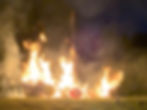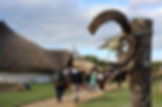Celebrating Autumn Equinox with the Viking Boat Burn at Butser Ancient Farm
7 min readButser Ancient Farm is an open air experimental archaeology museum on the Hampshire/Sussex border. At the Autumn Equinox they hold a...
Butser Ancient Farm is an open air experimental archaeology museum on the Hampshire/Sussex border. At the Autumn Equinox they hold a Saxon and Viking Fire Festival, which culminates in the dramatic burning of a Viking long boat in front of a sold out crowd as the sun sets. A fascinating event set in beautiful countryside, the Fire Festival is a unique and enriching historical experience.

Butser Ancient Farm
Established in 1970, Butser Ancient Farm was developed to test archaeologist’s theories about habitation construction and the practical side of life in the ancient world. Filled with authentically constructed dwellings, each year sees them add new ones, and the site now covers buildings from the Stone Age through to the Anglo Saxons. Last year they successfully ran a Roman hypocaust for ten days to see its impact on the building and mosaics above it, and other recent developments include an outdoor mosaic made from original tesserae found during the construction of the M4 in nearby Wiltshire.

Set in a verdant valley conveniently just off the A3, the farm is open to the public during the summer months as well as to countless school groups who go to learn about ancient civilisations in these authentic buildings. There are also workshops relating to all things to do with the ancient world such as cooking, manufacturing, technologies, music and much more.
One of the best aspects of Butser though is the annual celebrations of ancient customs to mark the changing seasons. In a modern world where we only recognise the changes by perhaps a change of wardrobe, gifts at Christmas or chocolate for Easter, Butser has brought back many of the old pre-Christian festivities which recognise our pagan heritage. The calendar at Butser includes Beltane, Samhain and Imbolc amongst others, each one celebrated in a unique way and which harks back to when our lives were dictated solely by the seasons and their impact on our ability to grow food.
The Autumn Equinox
The Autumn Equinox is celebrated by many cultures both past and present. Around the 21st of September, it marks the end of summer and the start of autumn and along with the Spring Equinox, is the only time in the year when the sun is exactly above the equator and day and night are of equal length.
The Autumn Equinox in Viking history was closely connected to farming, a time of harvesting crops and preparation for the bleak winter ahead. After a year of strenuous labour, it was a time when days became shorter and nights longer, the harvest was complete and thanks needed to be given to the gods, the people and the land for what had been produced – hopefully enough to last until the coming of new life in the spring.

It was a time of festivities around the fire to, “praise, … the Fire Element, because the world itself would take its colours. The fields are veiled by a cloth in tones of fire, dark yellow, red and oranges, the skies at dusk emit a red light that resembles blood, a warning that the days ahead will be hard.
The forests and the mountains become silent, most animals … store food and hide in holes or inside old trees, others will hibernate, ravens will go … from place to place in search of those who did not survive the hazards of the season and the harsh weather. ” (Arith Harger)
The burning of Viking boats is thought to be traditionally done when a chief died, his burning long ship sent out to sea with his body on board to be sent to Valhalla for the afterlife. Although there is some academic dispute over this, as many chiefs were buried in their boats underground, this is the common perception of the significance of the burning long boat, and in fact it is something celebrated in several festivals in the British Isles, namely in Up Helly Aa and another in Framlington.
The Saxon and Viking Fire Festival at Buster 2023
The event, which is one of their major fundraising events of the year to enable the farm to keep going, sells out far in advance and it attracts an eclectic mix of people. There are the history fans in sensible coats and walking boots, reenactors in woolen capes and helmets, pagans in flowing gothic dresses or medieval gowns underneath their capes and I even saw an Edwardian lady complete with beribboned boater thrown into the mix. It makes for a veritable feast for the eyes and adds a real air of festivity to the event.
On the warm September afternoon, people arrived at the farm gradually, many on foot but others bumping down the narrow road to the car park where cheerful volunteers steered everyone into their grassy parking spots. Through ticket and bag checks to the site itself, where at the end on a small hill was the highlight of the event – the Viking longboat which was awaiting its fate later on in the evening. People wandered up to inspect it and to take photos. Made from woven willow and decorated with shields, oars, a colourful sail and a dragon head, it was a quite a work of art. Behind it was a clothed straw dummy, waiting for his journey to Valhalla later on. People were soon tying their wishes to the willow, donating £1 to charity to write their wish on a scrap of paper and add it to the boat, to go up in flames to the heavens later on.
The festivities kicked off with Dark Morris dancers in front of the small outdoor stage in the field, which hosted acts throughout the evening until it was time for the procession to the Viking boat. These included a band called Perkelt who soon had the audience dancing in the sunshine with their fast Celtic tunes and furious fiddle playing. Fire performers danced and did tricks as visitors unravelled their picnic blankets, set up chairs and drank mead as the shadows lengthened.
There are so many activities laid on that it is impossible to do them all. On the more academic side of things were talks which included Women in the Viking Age, the Ancient Art of Plant Dyeing and Viking Star Navigation from Hants Astro, who had telescopes set up in a corner for visitors to peer through at the skies above.
The Saxons and Vikings inhabited the British Isles at the same time, and both feature in the Autumn Equinox festival. The highlight was a Viking vs Saxon battle in the Battle Paddock, surrounded by crowds watching the lighthearted battle with much delight, cheering the Saxons on and really getting into the spirit of it all.
There were a lot of activities for children, who all seemed to be really enjoying their day in the past. Striking their own Iron Age coins, decorating biscuits with ancient runes, archery, making drums, listening to the storytellers and getting their faces painted in their chosen warrior allegiances seemed to keep them all highly entertained.
A drum awakening ceremony was held in the large roundhouse, smoke from the central fire swirling around us all sitting on hay bales covered in animal skins before rising through the thatch and across the valley. A bronze sword was cast in the forge, the prize for the lucky winner of the raffle. A smithy was set up and surrounded by fascinated visitors, there were displays of weaving and other crafts, as well as living historians on hand to talk about what they were doing.
There were plenty of food stalls, including a huge hog roast which didn’t seem to last long, as well as others selling vegan and sweet options. The bars did a roaring trade of ale, cider made especially for the festival and of course the ubiquitous mead, a bottle of which was clutched in many an adult hand. Other stalls included those selling beeswax products, herbs and garlands, metal badges and wiccan ornaments
The highlight of the evening was of course the burning of the long boat. As the sun set, people drifted over to the hill and found places to sit, watching the fire performers as everyone settled down. The procession could soon be heard making its way across the site and the crowds parted as they walked up the hill to the ship to chanting and the pounding of drums. A small ceremony was held by two Viking women:
“A mighty warrior has fallen and begun his journey to the next world, there he will feast and drink while we tell stories of his greatest feats. Let us send him on his way with flame and with fire. Let them hear us in the distant halls where we cannot tread until our time is called. Let them hear our howls of triumph, our cries of agony and let them once again hear the beat of the drum. On this night, we shall dance as the darkness crawls in and we shall raise our voices to remember them”

To the beating of drums, three archers drew their bows with fiery arrows and fired them at the boat, with cries of, ‘To Valhalla”. After a couple of tries, the boat was soon aflame, and the warriors hollered, whooped and beat their drums as we all watched it go up in flames.
The sail burnt quickly, the oars and shields took the longest; their silhouettes visible through the intense orange of the fire as it is crackled, hissed and spat against the night sky.
Only when the fire started to diminish and reduce to a dull glow did the crowds slowly turn their backs and walk away from that most amazing spectacle, many buying a final bottle of mead as they headed back to their cars and start the drive back up the narrow roads to the A3 and home, the fire still roaring in ears, the smoke still wreathed through hair and clothes
Visit the Butser website and sign up to their mailing list for details of tickets to future boat burns and all the other wonderful events they put on throughout the year.



